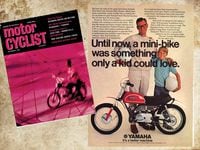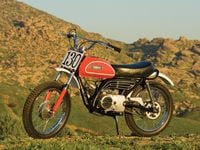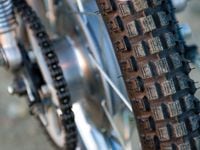The year 1971 was a doozy on entertainment and historical fronts. All in the Family debuted on CBS. Led Zeppelin played “Stairway to Heaven” for the first time to a live audience. George Harrison released “My Sweet Lord.” And Apollo 14 got back on the moon after Apollo 13’s near-debacle.
Motorcyclists had plenty to be excited about in '71 as well. Bruce Brown's moto documentary On Any Sunday, starring Steve McQueen, Mert Lawwill, and SoCal racer Malcolm Smith, opened to rave reviews nationally and garnered an Oscar nomination.
But it was motorcycling’s kids who let out the biggest whoops of joy that year because in ’71 no fewer than four amazing new minicycles were introduced: Honda’s SL70 Motosport, Rupp’s Black Widow, Suzuki’s MT50 Trailhopper, and Yamaha’s JT-1, also known as the Mini Enduro.
The term minicycle raises few eyebrows today, but in ’71 it was a fresh idea. The vast majority of minis prior to that point, aside from some funky Benellis and the ubiquitous Honda Z50 of ’68, were exactly what most baby boomers conjure when they hear the word minibike: a tube- and rigid-framed two wheeler with small, squared-off tires, a rear-tire-friction rear brake, truly evil handling, and motive power by either Briggs & Stratton or Tecumseh. No one complained about these things at the time, but no one knew better either.
Those four new minis were different, especially the SL70 and Mini Enduro, which were 3/5-scale versions of the SL175 and SL350 and the now legendary 250cc DT-1 of ’68. These were real motorcycles, shrunk in size for the little ones, that fired the imaginations of millions of boomer-aged kids like nothing imaginable. A red SL70 was this author’s very first motorcycle, and it led directly to a lifetime of two-wheeled fun and employment. Sales of these minis skyrocketed overnight and sucked millions of kids into motorcycling’s maw along the way.
Launched at the 1970 Yamaha dealer meeting, the Mini Enduro was an instant sensation. "I introduced the thing to dealers by carrying it out onto the stage," says AMA Hall of Fame inductee and longtime product-planning guru Ed Burke. "Dealers knew instantly what it was all about, just by seeing it. I have to say, it was probably the easiest development project I was ever involved in. The engineers in Japan seemed to know exactly what we were going to ask for in those days, and they seemed to have that little thing ready to go right when we asked for a miniature version!
“There was no mystery to what it needed to be,” Burke adds. “A small DT-1, really, it having become the dual-purpose machine by that point. We just kept building them smaller and smaller, and when we finally got to the minibike, everyone knew it would be a huge hit. And, boy, was it ever!”
Even today, in the face of advanced, ultra-modern minibikes, the JT-1 looks near-perfect—handsome, athletic, purposeful, well proportioned—and was stunningly transformative for baby boomers, which is why they’re restored, collected, ridden, and displayed in garage rafters and living rooms by aging boomers everywhere.
"While vacationing in Northern California several years ago, I found a restored JT-1—my first real motorcycle—on eBay," remembers longtime Motorcyclist photographer Kevin Wing. "It was not cheap, but it was perfect and local, too, and within a few minutes I'd bought it. I couldn't help myself. I had to have it!"
The Mini Enduro was not a technical tour de force. Its 58cc rotary-valve two-stroke single, fed by a tiny, 16mm Mikuni and lubricated by a no-fuss Autolube system, made very little power. But it was durable and reliable, and even after a long winter’s nap in the Midwest and northern tier of the country, they fired right up come springtime. (Try that nowadays.) The suspension was a bit flaccid for larger kids thanks to el-cheapo shocks and a fork assembly with just one spring in one fork leg. But 60-pound Jeff Ward, who Cycle magazine had evaluate the JT-1 for its October 1970 road test, seemed happy with the suspension. “He liked the way the bike absorbed the jolts before they could get to his backside,” Cycle wrote.
Overall, the JT-1 was balanced and handled quite well, and kids didn’t really care much about ride quality anyway; all they knew was that the thing was more fun and freedom-generating than anything else in their lives. And at less than $300, the JT-1 was affordable, and parents—many of them DT-1 owners—bought them by the bucket-load.
“It was just a crazy time,” Burke remembers. “JT-1s would come three to a crate, and dealers would buy 60 at a time. They’d tell us, ‘We can’t assemble ’em fast enough to keep ’em on the floor!’ Back then, there were so many places to ride, and the trail and riding-area closings hadn’t begun yet. Motorcycles were everywhere, and everyone seemed to be riding. One dealer in a little town called Sissonville, West Virginia, sold some 3,000 dual-sport Yamahas for us one year—DT-1s, AT-1s, and, of course, Mini Enduros. Amazing! It was a great time to be involved, and it highlighted how big motorcycling was in the early 1970s.”
Racing legend Jeff Ward rode and raced a Mini Enduro for a while, as did AMA National and Supercross Champion David Bailey. “The Mini Enduro was the first bike I ever rode,” Bailey remembers. “It was my stepdad Gary’s pitbike, and I just got attached to the thing. When I started racing it, Gary painted it to look like a Pursang, as he was racing Bultacos at the time; we called our JT-1 the YamaTaco!”
A lot of Mini Enduros were ridden into the ground in stock condition over the years, but many were also modified, most of those for racing. Larger carburetors, high-compression heads, special exhaust pipes, big-bore kits, and modified rotary valves gave them considerably more power. They were pretty competitive for a couple of years with the heavier SL70 four-strokes, though all that ended once the XR75 and YZ80 appeared in ’73 and ’74, respectively. “We helped ourselves a little by supporting a lot of minibike racing at the time,” Burke remembers. “We supported events at Indian Dunes and Escape Country.”
Cycle’s October 1970 test summarized the Mini Enduro pretty well: “Yamaha hit the nail on the head with the new baby Enduro. It’s better than a bicycle because you don’t have to pedal it; it’s better than most minibikes because it has real suspension units and a real transmission and the stability which comes from almost-full-sized wheels and tires; and it’s different from almost all minibikes in that it looks like a real motorcycle. The Mini is scheduled for release in October, just two months this side of Christmas. Yamaha even has the timing down cold.”
“I’d grown up on my brother’s hand-me-down JT-1,” remembers Wing, who still owns the bike photographed for this story, “and it’s amazing to have one just like it in the garage, especially with my old Indian Dunes number on the number plates. Every time I walk by it I’m only two kicks away from hearing that memorable sound, seeing the white puff of smoke, and smelling that burned two-stroke oil. When I do that, I’m instantly eight years old again.”











/cloudfront-us-east-1.images.arcpublishing.com/octane/T3MCT526H2G7SRQSQIJYHHR7V4.jpg)





/cloudfront-us-east-1.images.arcpublishing.com/octane/Y3B24QFQ64JYVKYJXL3VINHEJI.jpg)

/cloudfront-us-east-1.images.arcpublishing.com/octane/QCZEPHQAMRHZPLHTDJBIJVWL3M.jpg)
/cloudfront-us-east-1.images.arcpublishing.com/octane/HXOUJXQWA5HBHGRO3EMJIGFMVI.jpg)

/cloudfront-us-east-1.images.arcpublishing.com/octane/3TIWWRV4JBBOLDVGRYECVVTA7Y.jpg)
/cloudfront-us-east-1.images.arcpublishing.com/octane/KIX5O23D5NAIBGFXBN3327DKZU.jpg)
/cloudfront-us-east-1.images.arcpublishing.com/octane/7GJYDUIPXRGMTMQKN6ONYOLBOU.jpg)
/cloudfront-us-east-1.images.arcpublishing.com/octane/MUQLOVLL2ZDGFH25ILABNBXKTI.jpg)
/cloudfront-us-east-1.images.arcpublishing.com/octane/TNOU5DNE2BC57MFPMGN2EIDXAM.jpg)
/cloudfront-us-east-1.images.arcpublishing.com/octane/GTCXACQGJ5HAPDTGWUQKDEH44E.jpg)
/cloudfront-us-east-1.images.arcpublishing.com/octane/S35YGSEMEZB4BLTDJTSZPF4GLA.jpg)
/cloudfront-us-east-1.images.arcpublishing.com/octane/5UOT6HPX2JFMRJAX6EH45AR4MQ.jpg)
/cloudfront-us-east-1.images.arcpublishing.com/octane/OKWOJWAKP5EP3OACCRRWPCIX2Q.jpg)
/cloudfront-us-east-1.images.arcpublishing.com/octane/2WF3SCE3NFBQXLDNJM7KMXA45E.jpg)
/cloudfront-us-east-1.images.arcpublishing.com/octane/G4MG6OUCJNBSHIS2MVVOTPX65E.jpg)
/cloudfront-us-east-1.images.arcpublishing.com/octane/IIGGWFOTOJGB7DB6DGBXCCMTDY.jpg)
/cloudfront-us-east-1.images.arcpublishing.com/octane/QSTCM6AVEZA5JJBUXNIQ3DSOF4.jpg)
/cloudfront-us-east-1.images.arcpublishing.com/octane/U4I7G625B5DMLF2DVIJDFZVV6M.jpg)
/cloudfront-us-east-1.images.arcpublishing.com/octane/B6XD6LS6IVCQPIU6HXDJSM3FHY.jpg)
/cloudfront-us-east-1.images.arcpublishing.com/octane/ICL63FEDDRDTTMINYICCEYGMDA.jpg)
/cloudfront-us-east-1.images.arcpublishing.com/octane/FCGZHQXRBZFLBAPC5SDIQLVF4I.jpg)
/cloudfront-us-east-1.images.arcpublishing.com/octane/WNOB6LDOIFFHJKPSVIWDYUGOPM.jpg)

/cloudfront-us-east-1.images.arcpublishing.com/octane/X33NU3E525ECRHXLNUJN2FTRKI.jpg)
/cloudfront-us-east-1.images.arcpublishing.com/octane/6KKT5NNL2JAVBOXMZYS5ZO76YA.jpg)